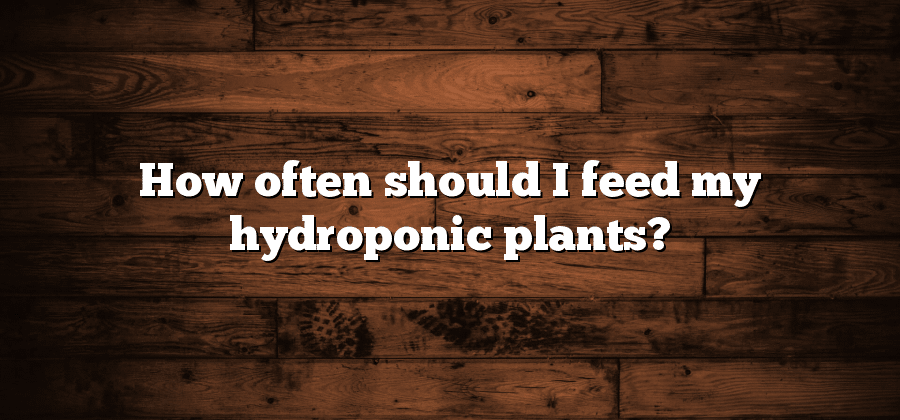Factors Affecting Feeding Frequency in Hydroponics
One of the key factors affecting feeding frequency in hydroponics is the type of plant being grown. Different plants have different nutrient requirements and growth rates, which can influence how often they need to be fed. For example, fast-growing plants that are actively producing fruits or flowers may require more frequent feeding to sustain their rapid growth. On the other hand, slow-growing plants that have lower nutrient demands may be able to thrive with less frequent feeding.
Another factor to consider is the stage of growth that the plants are in. During the early stages of growth, plants often require less frequent feeding as their nutrient demands are lower. However, as they reach their vegetative and reproductive stages, their nutrient requirements increase, resulting in the need for more frequent feeding. It is important for hydroponic growers to closely monitor the growth stages of their plants and adjust the feeding frequency accordingly to ensure optimal nutrition and growth.
Optimal Nutrient Uptake in Hydroponic Systems
Achieving optimal nutrient uptake in hydroponic systems is crucial for the healthy growth and development of plants. It requires a thorough understanding of the specific nutrient requirements of each plant species grown hydroponically. Nutrient solutions in hydroponics are carefully formulated to provide the essential elements needed by plants, such as nitrogen, phosphorus, potassium, and various micronutrients. However, simply providing these nutrients is not enough. Factors like pH levels, temperature, and nutrient concentration also play a significant role in determining the efficiency of nutrient uptake by the plants.
Maintaining the correct pH level is of utmost importance for optimal nutrient uptake. Most plants prefer a slightly acidic pH range, typically between 5.5 and 6.5. This range allows nutrients to remain available in the solution for absorption by the plant roots. Any significant deviation from the desired pH range can affect nutrient uptake negatively. Additionally, maintaining proper temperature levels is essential as it influences the rate of nutrient uptake. Warmer temperatures generally enhance nutrient absorption, while cooler temperatures can slow it down. To ensure optimal nutrient uptake, hydroponic growers should regularly monitor both the pH and temperature levels in their systems and make necessary adjustments if needed.
Identifying the Nutrient Requirements of Hydroponic Plants
In order to optimize the growth and yields of hydroponic plants, it is crucial to identify their specific nutrient requirements. Unlike traditional soil-based farming, hydroponics relies on a precise balance of essential nutrients that are directly supplied to the plant roots through water culture. Understanding these nutrient requirements is essential for maintaining healthy and productive hydroponic systems.
To identify the nutrient requirements of hydroponic plants, it is necessary to conduct thorough research and experimentation. Various factors can influence the nutrient needs of different plants, including species, growth stage, and environmental conditions. Additionally, the nutrient requirements may vary depending on the type of hydroponic system being used, such as Nutrient Film Technique (NFT), Deep Water Culture (DWC), or Drip Irrigation. Therefore, it is important to consult reliable resources, such as scientific publications or horticulture experts, to gather accurate information about the specific nutrient needs of the plants being cultivated in a hydroponic setup. By understanding and meeting these requirements, growers can ensure optimal growth, health, and productivity of their hydroponic plants.
Understanding the Growth Stages of Hydroponic Plants
Hydroponic plants go through distinct growth stages, each with its own unique characteristics and requirements. Understanding these growth stages can help growers optimize their hydroponic systems and ensure healthy and abundant plant growth.
The first stage is the seedling stage, which begins with the germination of seeds. During this stage, plants remain small and delicate, with underdeveloped root systems. They require a delicate balance of water, oxygen, and nutrients to support their growth. Careful monitoring of nutrient solutions and providing adequate light and temperature conditions are crucial for the healthy development of seedlings in hydroponic systems.
Monitoring the Nutrient Levels in Hydroponic Systems
One of the key components of successful hydroponic cultivation is monitoring the nutrient levels in the system. This is essential in order to ensure that plants are receiving the correct balance of essential elements for optimal growth and development. By regularly monitoring the nutrient levels, growers can make adjustments to the nutrient solution to prevent deficiencies or excesses that can negatively impact plant health.
There are several methods and tools available for monitoring nutrient levels in hydroponic systems. One common approach is the use of electrical conductivity (EC) meters, which measure the electrical conductivity or the ability of a solution to conduct electricity. This measurement is directly related to the concentration of dissolved nutrients in the solution. By measuring the EC of the nutrient solution, growers can determine if the nutrient levels are within the appropriate range and make necessary adjustments. Additionally, pH meters are used to measure the acidity or alkalinity of the nutrient solution, as pH levels can affect nutrient availability to plants. By regularly monitoring and adjusting the pH levels, growers can ensure optimal nutrient uptake by the plants.






